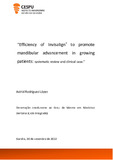Efficiency of Invisalign® to promote mandibular advancement in growing patients: systematic review and clinical case
Abstract
Introdução: A correcção da Classe II com retrognatia mandibular foi tratada com diferentes aparelhos funcionais que evoluíram ao longo do tempo permitindo um maior controlo e planeamento do avanço mandibular. Actualmente, temos a sistema Invisalign® que oferece o benefício de planear um avanço incremental personalizado, ao mesmo tempo que resolve o alinhamento. Isto, juntamente com a componente estética e removível, torna-a uma técnica muito atractiva para este tipo de tratamento.
Objetivo: Analisar a eficácia do avanço mandibular com o sistema Invisalign® obtendo os resultados da comparativa da revisão sistemática e estudo/resultados do caso clínico apresentado.
Materiais e Métodos: Foi realizado o estudo de um caso clínico no qual o avanço mandibular foi tratado com alinhadores com Precision Wings do sistema Invisalign®. Ao mesmo tempo, foi realizada uma pesquisa bibliográfica nas bases de dados PubMed, EBSCOhost, e Lilacs.
Resultados: O sistema Invisalign® apresenta resultados de efetividade no que respeita ao avanço da mandíbula no tratamento de pacientes em crecimiento, principalmente nos que se encuentram no estadio de maturação cervical CMV3; puberal.
Conclusão: O sistema Invisalign® pode ser considerado eficaz no tratamento do avanço mandibular, apresentando resultados semelhantes aos dos aparelhos removíveis convencionais. Contudo, não é tão eficiente quando comparado com os resultados obtidos com aparelhos fixos funcionais (Herbst ou Carriere). No entanto, são necessárias mais investigações. Introduction: Class II correction with mandibular retrognathia has been treated with different functional appliances that have evolved over time allowing for greater control and planning of mandibular advancement. Currently, we have the Invisalign® system that offers the benefit of planning a customized incremental advancement while resolving the alignment. This, along with the aesthetic and removable component, makes it a very attractive technique for this type of treatment.
Objective: To analyze the effectiveness of mandibular advancement with the Invisalign® system by comparing the results of a systematic review and a clinical case results.
Materials and Methods: The clinical case was performed in which mandibular advancement was treated by using Invisalign® System with Precision Wings. At the same time, a literature search was performed in PubMed, EBSCOhost, and Lilacs databases.
Results: Results: The Invisalign® system is effective in terms of mandibular advancement in the treatment of growing patients, mainly in those who are in a cervical maturing stage of CMV3; pubertal.
Conclusion: The Invisalign® system can be considered effective in the treatment of mandibular advancement, showing results similar to those of conventional removable appliances. However, it is not as efficient when compared to the results obtained by fixed appliances (Herbst or Carriere). However, further investigations are needed.

